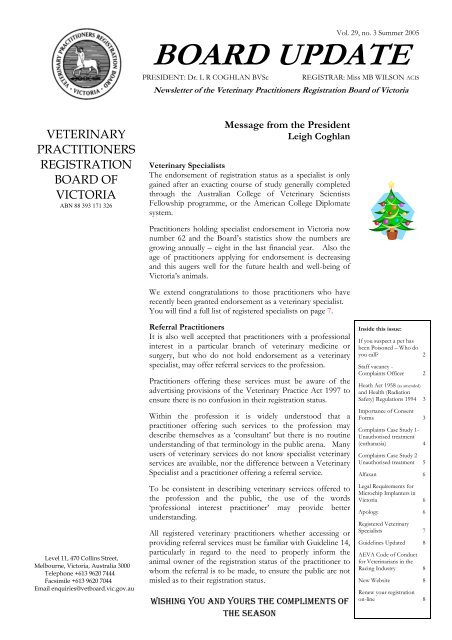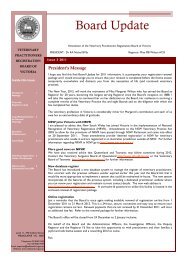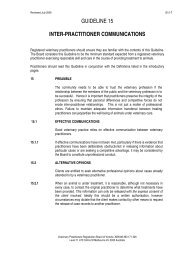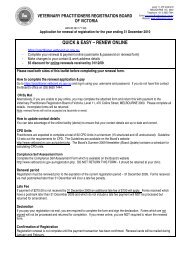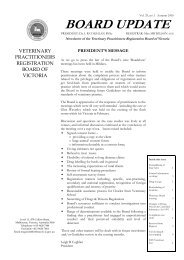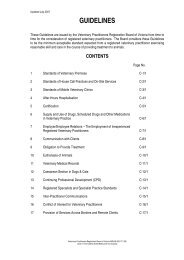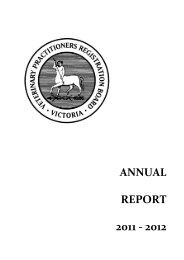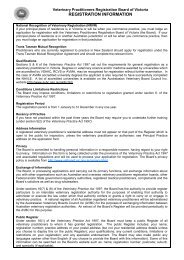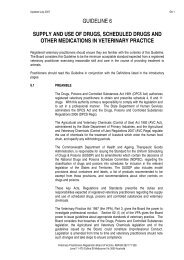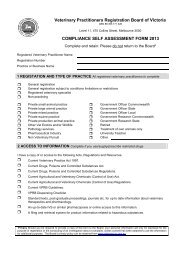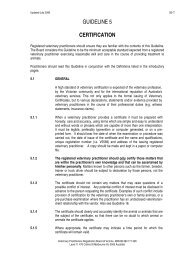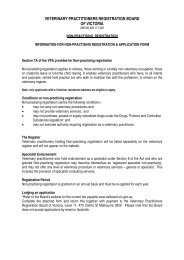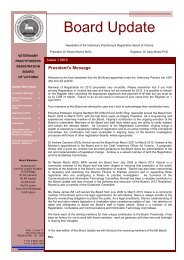board update - Veterinary Practitioners Registration Board of Victoria
board update - Veterinary Practitioners Registration Board of Victoria
board update - Veterinary Practitioners Registration Board of Victoria
Create successful ePaper yourself
Turn your PDF publications into a flip-book with our unique Google optimized e-Paper software.
Vol. 29, no. 3 Summer 2005<br />
BOARD UPDATE<br />
PRESIDENT: Dr. L R COGHLAN BVSc<br />
REGISTRAR: Miss MB WILSON ACIS<br />
Newsletter <strong>of</strong> the <strong>Veterinary</strong> <strong>Practitioners</strong> <strong>Registration</strong> <strong>Board</strong> <strong>of</strong> <strong>Victoria</strong><br />
VETERINARY<br />
PRACTITIONERS<br />
REGISTRATION<br />
BOARD OF<br />
VICTORIA<br />
ABN 88 393 171 326<br />
Message from the President<br />
Leigh Coghlan<br />
<strong>Veterinary</strong> Specialists<br />
The endorsement <strong>of</strong> registration status as a specialist is only<br />
gained after an exacting course <strong>of</strong> study generally completed<br />
through the Australian College <strong>of</strong> <strong>Veterinary</strong> Scientists<br />
Fellowship programme, or the American College Diplomate<br />
system.<br />
Level 11, 470 Collins Street,<br />
Melbourne, <strong>Victoria</strong>, Australia 3000<br />
Telephone +613 9620 7444<br />
Facsimile +613 9620 7044<br />
Email enquiries@vet<strong>board</strong>.vic.gov.au<br />
<strong>Practitioners</strong> holding specialist endorsement in <strong>Victoria</strong> now<br />
number 62 and the <strong>Board</strong>’s statistics show the numbers are<br />
growing annually – eight in the last financial year. Also the<br />
age <strong>of</strong> practitioners applying for endorsement is decreasing<br />
and this augers well for the future health and well-being <strong>of</strong><br />
<strong>Victoria</strong>’s animals.<br />
We extend congratulations to those practitioners who have<br />
recently been granted endorsement as a veterinary specialist.<br />
You will find a full list <strong>of</strong> registered specialists on page 7.<br />
Referral <strong>Practitioners</strong><br />
It is also well accepted that practitioners with a pr<strong>of</strong>essional<br />
interest in a particular branch <strong>of</strong> veterinary medicine or<br />
surgery, but who do not hold endorsement as a veterinary<br />
specialist, may <strong>of</strong>fer referral services to the pr<strong>of</strong>ession.<br />
<strong>Practitioners</strong> <strong>of</strong>fering these services must be aware <strong>of</strong> the<br />
advertising provisions <strong>of</strong> the <strong>Veterinary</strong> Practice Act 1997 to<br />
ensure there is no confusion in their registration status.<br />
Within the pr<strong>of</strong>ession it is widely understood that a<br />
practitioner <strong>of</strong>fering such services to the pr<strong>of</strong>ession may<br />
describe themselves as a ‘consultant’ but there is no routine<br />
understanding <strong>of</strong> that terminology in the public arena. Many<br />
users <strong>of</strong> veterinary services do not know specialist veterinary<br />
services are available, nor the difference between a <strong>Veterinary</strong><br />
Specialist and a practitioner <strong>of</strong>fering a referral service.<br />
To be consistent in describing veterinary services <strong>of</strong>fered to<br />
the pr<strong>of</strong>ession and the public, the use <strong>of</strong> the words<br />
‘pr<strong>of</strong>essional interest practitioner’ may provide better<br />
understanding.<br />
All registered veterinary practitioners whether accessing or<br />
providing referral services must be familiar with Guideline 14,<br />
particularly in regard to the need to properly inform the<br />
animal owner <strong>of</strong> the registration status <strong>of</strong> the practitioner to<br />
whom the referral is to be made, to ensure the public are not<br />
misled as to their registration status.<br />
WISHING YOU AND YOURS THE COMPLIMENTS OF<br />
THE SEASON<br />
Inside this issue:<br />
If you suspect a pet has<br />
been Poisoned – Who do<br />
you call? 2<br />
Staff vacancy -<br />
Complaints Officer 2<br />
Heath Act 1958 (as amended)<br />
and Health (Radiation<br />
Safety) Regulations 1994 3<br />
Importance <strong>of</strong> Consent<br />
Forms 3<br />
Complaints Case Study 1-<br />
Unauthorised treatment<br />
(euthanasia) 4<br />
Complaints Case Study 2<br />
Unauthorised treatment 5<br />
Alfaxan 6<br />
Legal Requirements for<br />
Microchip Implanters in<br />
<strong>Victoria</strong> 6<br />
Apology 6<br />
Registered <strong>Veterinary</strong><br />
Specialists 7<br />
Guidelines Updated 8<br />
AEVA Code <strong>of</strong> Conduct<br />
for Veterinarians in the<br />
Racing Industry 8<br />
New Website 8<br />
Renew your registration<br />
on-line 8
IF YOU SUSPECT A PET HAS BEEN POISONED – WHO DO YOU CALL?<br />
from Department <strong>of</strong> Primary Industries Chemical Standards<br />
<strong>Veterinary</strong> practitioners are almost always the first<br />
port <strong>of</strong> call when an individual suspects their pet<br />
may have ingested a poison. The Department <strong>of</strong><br />
Primary Industries (DPI) Chemical Standards has a<br />
regulatory role in investigating the misuse <strong>of</strong><br />
agricultural and veterinary chemicals. The most<br />
common chemicals involved in poisoning <strong>of</strong><br />
domestic pets are strychnine, fox baits containing<br />
1080, and certain organophosphate or carbamate<br />
insecticides.<br />
Although experienced veterinarians are <strong>of</strong>ten<br />
confident in recognising the signs <strong>of</strong> poisoning<br />
due to chemicals such as 1080, strychnine and<br />
organophosphates, DPI has encountered<br />
difficulty in conducting investigations due to the<br />
subjective nature <strong>of</strong> clinical diagnosis, and the<br />
lack <strong>of</strong> samples being taken. In any investigation<br />
it is vital that evidence is gathered to determine<br />
the true cause <strong>of</strong> the poisoning, that other causes<br />
are ruled out, and that all evidence is preserved<br />
intact. Some past investigations have been<br />
compromised by lack <strong>of</strong> samples, or poor<br />
practices such as the storing <strong>of</strong> samples, ie animal<br />
stomach contents, in used c<strong>of</strong>fee jars or shopping<br />
bags.<br />
The following points may help veterinarians to<br />
assist DPI investigators:<br />
• Conduct a necropsy, collect relevant samples,<br />
and contact DPI <strong>of</strong>ficers as soon as possible.<br />
• The type <strong>of</strong> sample(s) collected will depend<br />
upon the animal and what type <strong>of</strong> chemical you<br />
suspect has been the cause <strong>of</strong> the poisoning.<br />
Samples <strong>of</strong> the stomach contents and urine are<br />
<strong>of</strong> particular value and should be collected as<br />
COMPLAINTS OFFICER<br />
Part-time position 3 days per week<br />
Responsible for the day-to-day handling <strong>of</strong><br />
complaints lodged with the <strong>Board</strong> against registered<br />
veterinary practitioners. Hands-on position will suit<br />
someone with knowledge <strong>of</strong> disciplinary process in a<br />
health related field, who possesses patience,<br />
diplomacy, good writing skills, pr<strong>of</strong>iciency in<br />
soon as possible.<br />
• Make sure samples cannot be tampered with<br />
– the principle <strong>of</strong> continuity <strong>of</strong> evidence is<br />
critical in an investigation, especially when it<br />
proceeds to prosecution.<br />
• Ensure samples are sealed in leak-pro<strong>of</strong><br />
containers and cannot be contaminated.<br />
Samples should ideally be stored in clean,<br />
sterile containers to rule out contamination<br />
from past storage items. Each sample should<br />
be clearly labelled with the nature <strong>of</strong> sample<br />
(s) and date collected. Freezing may better<br />
preserve the samples.<br />
• Keep notes relating to the clinical signs <strong>of</strong> the<br />
animal in question. Background notes can<br />
help guide an investigation in the right<br />
direction by narrowing down the field <strong>of</strong><br />
possible chemicals.<br />
DPI Chemical Standards has Chemical Standards<br />
Officers located throughout the state who<br />
investigate poisonings involving the suspected<br />
misuse <strong>of</strong> agricultural and veterinary chemicals.<br />
Animals may be poisoned by chemicals that fall<br />
outside the range <strong>of</strong> interest <strong>of</strong> the DPI, however<br />
veterinary practitioners are encouraged to contact<br />
their local Chemical Standards Officer to discuss<br />
any issues they may have.<br />
If you have an animal that may have been<br />
poisoned by the misuse <strong>of</strong> an agricultural or<br />
veterinary chemical, please call the DPI customer<br />
service centre on 136 186 and ask to speak to the<br />
Chemical Standards Officer nearest to your<br />
location.<br />
Micros<strong>of</strong>t Office suite and who has had<br />
experience working as part <strong>of</strong> a small team in an<br />
administrative support environment. Registered<br />
veterinary practitioner or experience in the<br />
veterinary pr<strong>of</strong>ession may be an advantage. Copy<br />
<strong>of</strong> the position description may be obtained by<br />
telephone or email to contacts below. Written<br />
applications addressed in confidence to the<br />
Registrar, will be received by mail, facsimile or<br />
email up to close <strong>of</strong> business Friday 16 December<br />
2005.<br />
<strong>Veterinary</strong> <strong>Practitioners</strong> <strong>Registration</strong> <strong>Board</strong> <strong>of</strong> <strong>Victoria</strong><br />
11/470 Collins Street Melbourne Vic 3000<br />
Facsimile (03) 9620 7044<br />
Email registrar@vet<strong>board</strong>.vic.gov.au<br />
Page 2 <strong>of</strong> 8
BOARD UPDATE VOL. 29, no 3 Summer 2005<br />
THE HEALTH ACT 1958 (AS AMENDED) AND HEALTH (RADIATION SAFETY)<br />
REGULATIONS 1994.<br />
The responsibilities <strong>of</strong> <strong>Veterinary</strong> <strong>Practitioners</strong> under these regulations<br />
from the Radiation Safety Unit, Department <strong>of</strong> Human Services<br />
<strong>Practitioners</strong> are asked to be aware <strong>of</strong> the various<br />
Acts & Regulations’ which are relevant to their<br />
pr<strong>of</strong>essional activities. In particular, practitioners are<br />
reminded that there are several obligations that must<br />
be adhered to when providing radiological services<br />
in their practices.<br />
<strong>Registration</strong> <strong>of</strong> irradiating apparatus is mandatory<br />
under these <strong>Victoria</strong>n regulations. <strong>Registration</strong><br />
must be renewed yearly upon payment <strong>of</strong> the<br />
prescribed fees. Application forms for equipment<br />
registration may be obtained by contacting the<br />
Radiation Safety Program on 1300-767-469. Any<br />
change in equipment or ownership is to be reported<br />
to this same body. <strong>Registration</strong> carries several<br />
conditions <strong>of</strong> use and it is important that<br />
practitioners familiarise themselves with these<br />
obligations and ensure that these requirements are<br />
met.<br />
The above Act also states that: a person must not<br />
operate, use, store,…sell, possess, install, service, maintain,<br />
repair, test, dispose <strong>of</strong> or otherwise deal with an ionising<br />
radiation apparatus….unless the person is a holder <strong>of</strong> a<br />
licence.<br />
The Act provides for registered veterinarians to be<br />
granted an operator licence to use irradiating<br />
apparatus. <strong>Veterinary</strong> practices that wish to use<br />
unsealed radioisotopes must also obtain a<br />
Management Licence to do so. <strong>Veterinary</strong><br />
<strong>Practitioners</strong> must have their operator licence<br />
endorsed to indicate that they have had suitable<br />
training to carry out the procedures.<br />
Application for operator licences can be obtained<br />
by contacting the Radiation Safety Program or<br />
downloading from their WEB site:<br />
www.health.vic.gov.au/environment/radiation<br />
Allow 3-5 working days for a new application to<br />
be processed.<br />
The wearing <strong>of</strong> personal radiation monitors is<br />
mandatory when operating an irradiating device<br />
or working with radioactive sources. Monitors<br />
can be obtained from:<br />
ARPANSA: prms@arpansa.gov.au –<br />
Tel: 03-9433-2211<br />
Or<br />
ARS: Tel:03-9873-0088 (Dr Joe Young)<br />
Or<br />
Radiation Wise: Tel: 08-9457-1698<br />
It is recommended that <strong>Veterinary</strong> <strong>Practitioners</strong><br />
obtain a copy <strong>of</strong> the ‘Radiation Protection Series<br />
Publications’, No. 1 as well as RHS 3 and 10:<br />
‘Code <strong>of</strong> practice for the safe use <strong>of</strong> ionizing<br />
radiology in veterinary radiology: Parts 1 and 2<br />
(1982) and part 3- radiotherapy- (currently under<br />
review).<br />
These can be downloaded from ARPANSA:<br />
www.arpansa.gov.au<br />
<strong>Practitioners</strong> are encouraged to refer any queries<br />
they may have to the Radiation Safety Program<br />
on 1300-767-469 or by emailing to:<br />
radiation.safety@dhs.vic.gov.au<br />
THE IMPORTANCE OF CONSENT FORMS<br />
Guideline 8 discusses communication with<br />
clients especially regarding informing the client<br />
about all available options and recording informed<br />
consent for the chosen option. The <strong>Board</strong> <strong>of</strong>ten<br />
has complaints based on inadequate explanation <strong>of</strong><br />
options <strong>of</strong> treatment and furthermore, the lack <strong>of</strong><br />
consent for those treatments.<br />
The <strong>Board</strong> recommends that consent forms are<br />
used to record the client’s understanding <strong>of</strong> all the<br />
procedures and the risks involved. These consent<br />
forms should mention the risks (and costs)<br />
involved for the treatment, especially if it involves<br />
sedation, anaesthetic and surgery. They should be<br />
signed by the client and a copy should be<br />
provided to the client to ensure that they are<br />
aware <strong>of</strong> their commitments.<br />
The consent forms should be easily retrievable<br />
and are expected to be kept for a minimum <strong>of</strong> 7<br />
years. Commonly, although a verbal discussion <strong>of</strong><br />
treatment, options, risks and cost does take place,<br />
the client does not always comprehend the<br />
situation and later say they did not consent to<br />
treatment. Options should be recorded on the<br />
clinical records for your information and on a<br />
signed consent form for the client’s information.<br />
Page 3 <strong>of</strong> 8
COMPLAINTS CASE STUDIES<br />
CASE STUDY 1 : Unauthorised treatment (euthanasia)<br />
The complainant states that the cat gave birth to<br />
one kitten and became distressed with difficulty<br />
delivering other kittens. The cat was presented to a<br />
veterinary practitioner and was admitted for<br />
medication to induce labour. The complainant left<br />
the kitten with the cat to feed and was informed if<br />
medication did not work surgery would be required.<br />
The veterinary practitioner quoted up to $400 and<br />
explained that payment options were available. The<br />
complainant declined this <strong>of</strong>fer due to the costs<br />
involved. The veterinary practitioner arranged for<br />
the complainant to surrender the cat if surgery was<br />
required so that it could either be re-homed after<br />
surgery or euthanised. The veterinary practitioner<br />
directed the owner to reception to surrender the cat<br />
leaving the practice to determine its fate if the<br />
injection was unsuccessful. The complainant agreed<br />
to this.<br />
Some hours later the complainant discovered the<br />
treatment had not been successful and the cat was<br />
to be euthanised as permission for re-homing it had<br />
not been granted by the clinicians. The veterinary<br />
practitioner states that a friend <strong>of</strong> the complainant’s<br />
was spoken to, advising the outcome, and they gave<br />
permission for euthanasia. The complainant states<br />
the veterinary practitioner spoke to him over the<br />
telephone, not his friend. He gave authorisation for<br />
euthanasia for the cat.<br />
The complainant later discovered that the kitten had<br />
also been euthanised. The next day the veterinary<br />
practitioner told the complainant’s friend that the<br />
kitten was euthanised with the cat because it was<br />
assumed the complainant was not interested in it.<br />
The veterinary practitioner had not spoken to the<br />
complainant regarding options for the kitten and<br />
the complainant was upset that it had been<br />
euthanised without consent.<br />
The nurse informed the veterinary practitioner that<br />
the surrender form was signed for both the cat and<br />
the kitten. The veterinary practitioner could not<br />
find the form as it is filed separately by number and<br />
there is no connection made to the clinical records<br />
in accordance with the practice’s current policy.<br />
An informal hearing was held into the matter.<br />
There was concern that the veterinary practitioner<br />
did not obtain permission or a consent form for<br />
euthanasia <strong>of</strong> the day-old kitten. The veterinary<br />
practitioner was found to have engaged in<br />
unpr<strong>of</strong>essional conduct and was cautioned as<br />
follows:-<br />
• To seek clear identification <strong>of</strong> the person you<br />
speak to over the phone when seeking<br />
permission for euthanasia<br />
• Ensure that you fully discuss costs, options<br />
for treatment or euthanasia for all animals<br />
with the owner<br />
• To ensure permission is granted in each and<br />
every case for euthanasia and other veterinary<br />
treatments<br />
The veterinary practitioner was also counselled as<br />
follows:-<br />
• To be responsible for ensuring that all<br />
appropriate documents are signed by the<br />
owner <strong>of</strong> an animal and that the owner<br />
understands the content <strong>of</strong> the documents<br />
• Consider the practice’s protocols and take<br />
responsibility to ensure they are adequate in<br />
each case<br />
• Familiarise yourself with hospital procedures<br />
involving the surrender <strong>of</strong> animals<br />
• Fulfil the requirements <strong>of</strong> the <strong>Board</strong>’s<br />
guidelines in particular Guideline 8 and<br />
Guideline 10<br />
• Ensure that copies <strong>of</strong> consent forms are<br />
given to the owner<br />
The veterinary practitioner admitted to the panel that<br />
consent for the euthanasia <strong>of</strong> the day old kitten was<br />
not obtained. The Panel determined that the<br />
veterinary practitioner did not seek specific<br />
instructions regarding the future <strong>of</strong> the kitten and as a<br />
result, the veterinary practitioner did not comply with<br />
Guideline 10.3 in that there was apparently no<br />
consent form signed for the euthanasia <strong>of</strong> the kitten.<br />
The veterinary practitioner stated the kitten was not<br />
considered at the time the person on the phone was<br />
spoken to when consent for euthanasia for the cat<br />
was given. At this time the kitten was not mentioned<br />
by either party. Also at the time <strong>of</strong> the initial<br />
consultation the veterinary practitioner believed the<br />
conservative treatment would be successful and,<br />
therefore, the future <strong>of</strong> the kitten was not considered.<br />
The Panel accepted the veterinary practitioner’s<br />
explanation that the cat’s admission form for<br />
treatment was discussed with the complainant, the<br />
form had been signed and a copy was given to the<br />
owner. However, the veterinary practitioner stated<br />
this was the first time they had personally organised a<br />
surrender form for an animal, was not familiar with<br />
its appearance or fully aware <strong>of</strong> procedures.<br />
Page 4 <strong>of</strong> 8
BOARD UPDATE VOL. 29, no 3 Summer 2005<br />
The responsibility <strong>of</strong> the paper work was left to the<br />
hospital receptionist. The Panel determined that as<br />
the veterinary practitioner did not find the<br />
surrender form for the cat that this form may not<br />
have existed and the veterinary practitioner was<br />
only relying on the verbal opinion <strong>of</strong> the veterinary<br />
nurse that it did exist. The veterinary practitioner<br />
stated that the practice information booklet does<br />
not mention surrender forms and it is not usual<br />
practice to give a copy to the owner. The Panel<br />
determined that the protocols at this practice were<br />
inadequate and required changes to be in line with<br />
the <strong>Board</strong>’s guidelines in that they must ensure that<br />
the details <strong>of</strong> owners and their pets are linked to the<br />
surrender form and that all information is retrievable.<br />
The Panel found that there was a difference <strong>of</strong><br />
opinion in what actually occurred during the phone<br />
call when consent for euthanasia was given and could<br />
not make a determination on that matter. The Panel<br />
found that the veterinary practitioner did not obtain<br />
clear identification <strong>of</strong> the caller when authorisation<br />
for euthanasia <strong>of</strong> the cat was obtained.<br />
Whilst it is understood that such a young kitten was<br />
not viable without its mother or a surrogate lactating<br />
queen, the Panel found that this had not been<br />
communicated to the owner who could not<br />
necessarily be expected to have this knowledge.<br />
CASE STUDY 2: Unauthorised treatment<br />
The complainant took a Heeler cross dog to see a<br />
specialist veterinary practitioner for a consultation<br />
regarding a ruptured cruciate ligament. The dog<br />
was examined, confirming diagnosis and whilst the<br />
veterinary practitioner was explaining the problem<br />
and possible surgical options to the complainant,<br />
he asked a vet nurse to take the dog outside. The<br />
complainant assumed this meant to enable the dog<br />
to relieve herself. After consultation and costs <strong>of</strong><br />
surgery were explained the complainant informed<br />
the veterinary practitioner she would discuss the<br />
options with her husband and went to retrieve her<br />
dog. The dog’s leg had been shaved and tubing<br />
had been inserted and taped over. The dog was<br />
taken home but was unable to stand or walk until<br />
the next morning. The complainant was very upset<br />
that this happened as no agreement had been made<br />
that surgery was to be performed at that time.<br />
The veterinary practitioner stated that the dog was<br />
referred for assessment and to provide accurate<br />
diagnosis so that appropriate surgical options could<br />
be <strong>of</strong>fered. On examination the dog was found to<br />
have a left anterior cruciate ligament rupture. In<br />
addition, thickening and discomfort involving the<br />
right knee was discovered. Light sedation with<br />
morphine and acepromazine was given to facilitate<br />
more accurate examination. This is the veterinary<br />
practitioner’s usual procedure for strong breed<br />
dogs with problems such as these. The drugs<br />
chosen were used as they have a less depressant<br />
effect on heart and circulatory function. The<br />
drawback is that they last up to 4 hours. The<br />
veterinary practitioner did not agree that the dog<br />
was catheterised or that any expectation was placed<br />
upon the complainant in regard to the dog having<br />
surgery immediately. The dog was difficult to<br />
restrain and the veterinary practitioner determined<br />
sedation was required in order to accurately assess<br />
the situation.<br />
An informal hearing was held into the matter.<br />
There was concern that the veterinary practitioner did<br />
not obtain consent from the client for administration<br />
<strong>of</strong> analgesia and sedation to the dog. The veterinary<br />
practitioner was found to have engaged in<br />
unpr<strong>of</strong>essional conduct and was cautioned as<br />
follows:-<br />
• That a signed consent form should be<br />
obtained for procedures involving<br />
administration <strong>of</strong> drugs for sedation and<br />
analgesia<br />
• Clients should be provided with a copy <strong>of</strong> the<br />
signed consent form and that it should be<br />
ensured that they understand its contents<br />
• That it should be specified in patient clinical<br />
records the type <strong>of</strong> drug administered, its<br />
dose and time <strong>of</strong> administration<br />
• That clients are made aware <strong>of</strong> the effects and<br />
possible side effects <strong>of</strong> drugs and <strong>of</strong> any after<br />
care required<br />
The Panel found the veterinary practitioner admitted<br />
to administering the morphine and acepromazine to<br />
the dog without prior consent from the complainant.<br />
The Panel understood the veterinary practitioner’s<br />
reasons for examining the dog with sedation and<br />
analgesia and agreed that for this type <strong>of</strong> dog this<br />
would be the best way to establish an accurate<br />
diagnosis. The Panel accepted the veterinary<br />
practitioner’s statement that it is usual practice to<br />
obtain signed consent forms for procedures and this<br />
case was an isolated incident.<br />
The Panel found that the veterinary practitioner did<br />
not clearly communicate the procedures to the<br />
complainant causing misunderstanding and distress to<br />
the complainant. The Panel accepted the statement<br />
that the dog was not catheterised or being prepped for<br />
surgery. The dog’s foreleg may have been clipped to<br />
administer the drugs <strong>of</strong> sedation and analgesia<br />
intravenously.<br />
Page 5 <strong>of</strong> 8
It was clear that the veterinary practitioner did not<br />
inform the complainant <strong>of</strong> the effects <strong>of</strong> this<br />
medication. This caused some distress to the<br />
complainant as they did not understand what was<br />
involved. The veterinary practitioner advised the<br />
Panel that dogs with this condition are usually<br />
admitted for surgery and therefore discharged at a<br />
later time when they are no longer under the<br />
influence <strong>of</strong> these drugs. The <strong>Board</strong> and the<br />
veterinary practitioner are aware <strong>of</strong> the<br />
complainant’s distress and the veterinary<br />
practitioner regrets the incident and <strong>of</strong>fered an<br />
apology.<br />
The Panel found that the veterinary practitioner did<br />
not record the drugs or the doses used in the clinical<br />
records for the dog. The Panel accepted the<br />
veterinary practitioner’s statement that this is normally<br />
recorded and was unable to explain why this was not<br />
completed in this case.<br />
The Panel understands that both verbal and written<br />
communications are essential in cases where any form<br />
<strong>of</strong> procedure is involved. The public has little<br />
understanding <strong>of</strong> the procedures involved in the<br />
diagnosis <strong>of</strong> specific conditions and relies on<br />
veterinary practitioners to be clear in communicating<br />
what is required.<br />
ALFAXAN®<br />
From Jurox Pty Ltd<br />
In the Winter 2005 <strong>Board</strong> Update the complaints case<br />
study no. 1 mentioned the use <strong>of</strong> Alfaxan® In<br />
response Jurox Pty Ltd has requested the <strong>Board</strong> to<br />
insert the following information.<br />
Alfaxan® was a product that was never registered for<br />
use in dogs. Alfaxan® was an image product <strong>of</strong> the<br />
very successful cat (and monkey) anaesthetic Saffan®.<br />
Both Alfaxan® and Saffan® were formulated in a<br />
Cremaphor carrier that was well known for initiating<br />
histamine release and anaphylactoid reactions that in<br />
dogs were potentially fatal, hence Alfaxan® was<br />
specifically registered for use in cats only.<br />
In the late 1990’s Jurox reformulated the active<br />
alphaxalone in a cyclodextran carrier and then developed<br />
Alfaxan®-CD (a powder for reconstitution) and further<br />
Alfaxan®-CD RTU. This resulted in a removal <strong>of</strong> the<br />
histamine release seen with Alfaxan® and Saffan®. Thanks<br />
to this Alfaxan®-CD RTU is now becoming more and more<br />
well known as a safe and reliable anaesthetic for use in both<br />
dogs and cats.<br />
Alfaxan®-CD RTU is a very different formulation <strong>of</strong><br />
alphaxalone, is registered for use in both dogs and cats and<br />
can be used with confidence in both species.<br />
Understanding the way people abbreviate drug names Jurox<br />
made the decision in 2002 to cease making and selling<br />
Alfaxan®.<br />
LEGAL REQUIREMENTS FOR MICROCHIP IMPLANTERS IN VICTORIA<br />
From 1 December 2005 only registered veterinary<br />
practitioners or suitably qualified persons will be<br />
able to implant microchips into dogs and cats in<br />
<strong>Victoria</strong>.<br />
ALL persons, including registered veterinary<br />
practitioners, wishing to be authorised to implant<br />
will have to complete a microchip 'course' or, for<br />
future graduates, have done the specified training as<br />
part <strong>of</strong> their veterinary degree. This course is<br />
currently being developed by the AVA and will be<br />
set up to minimise the impost on veterinarians. The<br />
course is necessary to ensure veterinarians are aware <strong>of</strong><br />
the new legislative requirements and their<br />
responsibilities under legislation in regard to<br />
permanent identification, technology, record keeping<br />
and forwarding <strong>of</strong> information to registries (which will<br />
need to be licensed).<br />
For more information please call the Department <strong>of</strong><br />
Primary Industries on (03)9217 4347.<br />
APOLOGY<br />
In the Winter 2005 <strong>Board</strong> Update a list <strong>of</strong> registered<br />
veterinary specialists was given with incorrect<br />
information regarding those specialists whose<br />
speciality is <strong>Veterinary</strong> Surgery – Small Animal. It<br />
is unfortunate that ‘Surgery’ was replaced with<br />
‘Medicine’<br />
and we apologise to all those specialists whose listing<br />
was incorrect.<br />
A corrected listing can be found on the next page with<br />
the addition <strong>of</strong> two newly endorsed specialists.<br />
Page 6 <strong>of</strong> 8
BOARD UPDATE VOL. 29, no 3 Summer 2005<br />
REGISTERED VETERINARY SPECIALISTS<br />
to 3 November 2005<br />
RN NAME SN SPECIALIST CATEGORY/BRANCH<br />
365 BLOGG John Rowan 001 <strong>Veterinary</strong> Ophthalmology<br />
1335 LAVELLE Roger 002 <strong>Veterinary</strong> Radiology<br />
723 GUNN Ian 003 <strong>Veterinary</strong> Medicine – Cattle<br />
1353 VASEY James 004 <strong>Veterinary</strong> Surgery – Equine<br />
2027 EMMS Stephen 005 <strong>Veterinary</strong> Surgery – Small Animal<br />
1020 CUTLER Ross 007 <strong>Veterinary</strong> Medicine – Pig<br />
581 SULLIVAN Neill 009 <strong>Veterinary</strong> Pathobiology – Anatomic/Clinical<br />
873 LORDING Peter 010 <strong>Veterinary</strong> Pathobiology – General/Clinical<br />
2610 SLOCOMBE Ronald 011 <strong>Veterinary</strong> Pathobiology - Anatomic<br />
1347 PARRY Bruce 013 <strong>Veterinary</strong> Pathobiology - Clinical<br />
1451 MCKINNON Angus 014 <strong>Veterinary</strong> Reproduction - Equine<br />
1713 ROBERTSON-SMITH Russell 015 <strong>Veterinary</strong> Surgery - Equine<br />
424 MALMO Jakob 019 <strong>Veterinary</strong> Medicine - Cattle<br />
1138 MACLEAN Alastair 020 <strong>Veterinary</strong> Surgery - Equine<br />
778 CONDRON Robin 022 <strong>Veterinary</strong> Pathobiology - Microbiology<br />
566 STUDDERT Virginia 023 <strong>Veterinary</strong> Medicine – Cat & Dog<br />
1051 MASON Tony 027 <strong>Veterinary</strong> Surgery – Small Animal<br />
453 HAZARD Ge<strong>of</strong>frey 028 <strong>Veterinary</strong> Surgery - Equine<br />
890 LENGHAUS Cornelius 030 <strong>Veterinary</strong> Pathobiology - General<br />
1304 MCCOLL Kenneth 032 <strong>Veterinary</strong> Pathobiology – General/Anatomic/Microbiology<br />
1038 SMYTH George 033 <strong>Veterinary</strong> Surgery - Equine<br />
1306 VAN VEENENDAAL Johannes 034 <strong>Veterinary</strong> Surgery - Equine<br />
1959 STANLEY Robin 035 <strong>Veterinary</strong> Ophthalmology<br />
2722 NIMMO Judith 036 <strong>Veterinary</strong> Pathobiology – General/Anatomic<br />
502 CLARKE Roger 037 <strong>Veterinary</strong> Surgery – Small Animal<br />
807 HYLAND John 041 <strong>Veterinary</strong> Reproduction - Equine<br />
1661 MACKIE John 042 <strong>Veterinary</strong> Pathobiology – General/Anatomic<br />
1518 MACWHIRTER Patricia 043 <strong>Veterinary</strong> Medicine - Avian<br />
2911 MIDDLETON Deborah 046 <strong>Veterinary</strong> Pathobiology – General/Clinical/Anatomic<br />
1994 MERRETT Darren 047 <strong>Veterinary</strong> Medicine - Dog<br />
1385 TULLOCH John 048 <strong>Veterinary</strong> Medicine – Public Health<br />
669 SPEIRS Victor 049 <strong>Veterinary</strong> Surgery - Equine<br />
1444 COLES Stephen 050 <strong>Veterinary</strong> Surgery - Dentistry<br />
1115 TURNER Andrew 052 <strong>Veterinary</strong> Ophthalmology<br />
2136 LABUC Robert 055 <strong>Veterinary</strong> Medicine - Dog<br />
448 CHRISTIE Bruce 056 <strong>Veterinary</strong> Surgery – Small Animal<br />
665 ROBINSON Wayne 057 <strong>Veterinary</strong> Pathobiology - Anatomic<br />
2962 PRESTON Christopher 058 <strong>Veterinary</strong> Surgery – Small Animal<br />
4009 NICOLL Robert 059 <strong>Veterinary</strong> Radiology<br />
4012 ALLAN Graeme 060 <strong>Veterinary</strong> Radiology<br />
1904 BURTON Gregory 061 <strong>Veterinary</strong> Medicine - Dermatology<br />
1729 BENNETT Peter 062<br />
063<br />
<strong>Veterinary</strong> Medicine – Small Animal<br />
<strong>Veterinary</strong> Medicine - Oncology<br />
2668 HORN Birgitte 064 <strong>Veterinary</strong> Medicine - Dog<br />
2530 CLARKE David 065 <strong>Veterinary</strong> Surgery - Dentistry<br />
4179 LEAN Ian 066 <strong>Veterinary</strong> Medicine - Cattle<br />
2882 BECK Catherine 067 <strong>Veterinary</strong> Radiology<br />
2878 HARDMAN Chloe 068 <strong>Veterinary</strong> Ophthalmology<br />
2191 CAVALIERI John 070 <strong>Veterinary</strong> Reproduction<br />
2060 LAVERTY Peter 073 <strong>Veterinary</strong> Surgery – Small Animal<br />
1438 MCORIST Steven 074 <strong>Veterinary</strong> Pathobiology - Microbiology<br />
4543 MILLER Richard 075 <strong>Veterinary</strong> Pathobiology - General<br />
4551 KUNTZ Charles 076 <strong>Veterinary</strong> Surgery – Small Animal<br />
4601 WHITTON Robert 078 <strong>Veterinary</strong> Surgery - Equine<br />
4435 ROSS Anthony 080 <strong>Veterinary</strong> Pathobiology - Anatomic<br />
3613 O'REILLY Anu 081 <strong>Veterinary</strong> Ophthalmology<br />
3097 O'BRIEN Carolyn 082 <strong>Veterinary</strong> Medicine - Cat<br />
2177 WILLIAMSON Mark 083 <strong>Veterinary</strong> Pathobiology - Anatomic<br />
2693 KUDNIG Simon 084 <strong>Veterinary</strong> Surgery – Small Animal<br />
2798 WATTS John 085 <strong>Veterinary</strong> Reproduction – Small Animal<br />
3300 SNELLING Samuel 086 <strong>Veterinary</strong> Surgery – Small Animal<br />
3904 BASSETT Rebecca 087 <strong>Veterinary</strong> Medicine - Dermatology<br />
3386 NEIL Kirsten 088 <strong>Veterinary</strong> Medicine - Equine<br />
Page 7 <strong>of</strong> 8
GUIDELINES UPDATED<br />
Take this opportunity to <strong>update</strong> your handbook<br />
The <strong>Board</strong>’s guidelines 6, 7, 9, 11, 13, 17 and the<br />
definitions have been <strong>update</strong>d. You will be able to<br />
access the <strong>update</strong>d guidelines from the web page<br />
from the end <strong>of</strong> November 2005. Guidelines 8<br />
and 10 are being reviewed and will be <strong>update</strong>d on the<br />
web page in the New Year.<br />
For registered veterinary practitioners who do not<br />
have access to the web, one complete hard copy<br />
revised set will be posted to you on request to the<br />
<strong>Board</strong>’s <strong>of</strong>fices (9620 7444).<br />
Additional hard copy sets may be purchased for<br />
$55.00.<br />
AEVA CODE OF CONDUCT FOR VETERINARIANS IN THE RACING INDUSTRY<br />
In the last issue <strong>of</strong> <strong>Board</strong> Update reference was made<br />
to the <strong>Board</strong>’s recognition <strong>of</strong> the AEVA Code <strong>of</strong><br />
Conduct for Veterinarians in the Racing Industry.<br />
The <strong>Board</strong> has received feedback from veterinary<br />
practitioners about the obligations <strong>of</strong> veterinarians<br />
working in the racing industry and as a result has<br />
established a working group under the auspices <strong>of</strong><br />
the Guidelines Committee to further review this<br />
whole issue.<br />
In the meantime, the <strong>Board</strong> expects practitioners<br />
working within the racing industry to fully comply<br />
with <strong>Board</strong> Guideline 6, which is considered to be the<br />
critical reference document for all registered<br />
veterinary practitioners with respect to the supply and<br />
use <strong>of</strong> restricted drugs.<br />
In addition, the <strong>Board</strong> expects such practitioners to<br />
be familiar with, and ensure they are compliant with,<br />
the Rules <strong>of</strong> Racing as they relate to the supply and<br />
administration <strong>of</strong> drugs to racing animals.<br />
NEW WEBSITE<br />
Check it out and give us your feedback!<br />
The <strong>Board</strong>’s website has been re-designed and will be<br />
operational from December.<br />
The site has been designed in three main sections –<br />
Home; Public; Vets and takes advantage <strong>of</strong> drop<br />
down menus to make it easier to navigate.<br />
One <strong>of</strong> the newer facilities will be a “Latest News”<br />
section under the Vets Page – for advice about<br />
<strong>update</strong>s to the Guidelines and other information<br />
pertinent to registration.<br />
We think that you will find it easier to get around and<br />
look forward to your feedback.<br />
RENEW YOUR REGISTRATION ON-LINE<br />
Renewal <strong>of</strong> registration on-line is available from 1<br />
December 2005.<br />
Access to the on-line renewal facility is secure.<br />
Only practitioners who have a valid email<br />
address registered with the <strong>Board</strong> before 31<br />
October, and who are paying the standard fee<br />
may use this payment facility.<br />
All others will need to post their renewal<br />
applications to the <strong>Board</strong>’s <strong>of</strong>fice.<br />
Access www.vet<strong>board</strong>.vic.gov.au<br />
Choose the Vets page from the top <strong>of</strong> the screen<br />
Click on <strong>Registration</strong> and then choose Online<br />
Renewal from the drop down menu and follow<br />
the prompts.<br />
Remember – as a security measure, the<br />
system will NOT accept an email address not<br />
registered by 31 October.<br />
Renewal certificates will continue to be mailed to you as usual.<br />
The standard renewal fee will apply until midnight Australian Eastern Summer Time 31 December<br />
2005. From one minute past midnight the late renewal fee will apply until midnight Australian Eastern<br />
Standard Time 31 March 2006.<br />
Page 8 <strong>of</strong> 8


